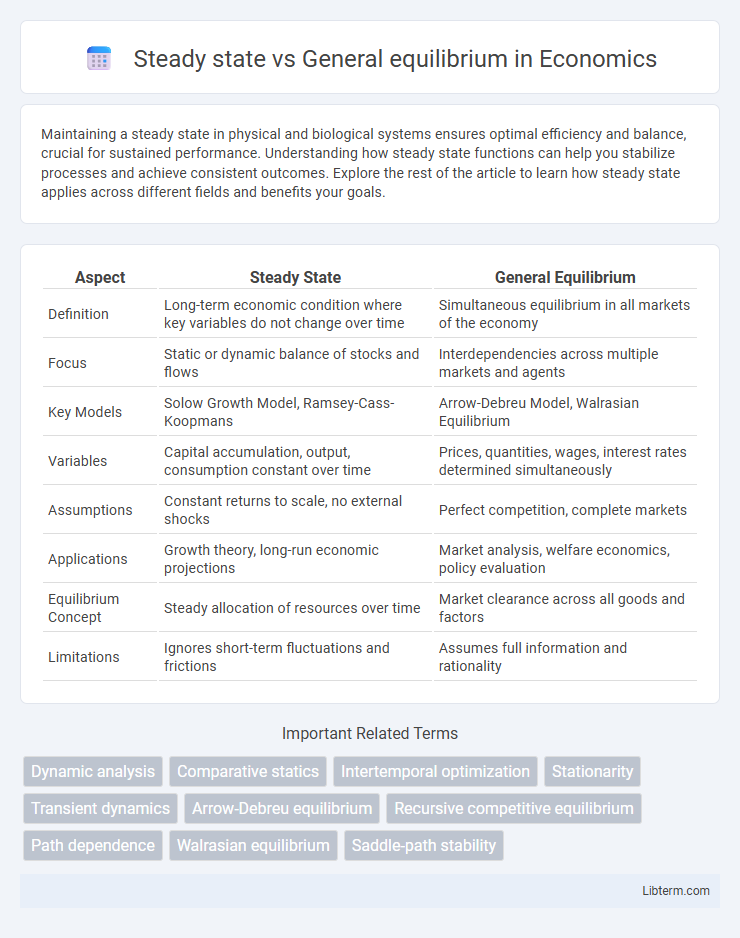Maintaining a steady state in physical and biological systems ensures optimal efficiency and balance, crucial for sustained performance. Understanding how steady state functions can help you stabilize processes and achieve consistent outcomes. Explore the rest of the article to learn how steady state applies across different fields and benefits your goals.
Table of Comparison
| Aspect | Steady State | General Equilibrium |
|---|---|---|
| Definition | Long-term economic condition where key variables do not change over time | Simultaneous equilibrium in all markets of the economy |
| Focus | Static or dynamic balance of stocks and flows | Interdependencies across multiple markets and agents |
| Key Models | Solow Growth Model, Ramsey-Cass-Koopmans | Arrow-Debreu Model, Walrasian Equilibrium |
| Variables | Capital accumulation, output, consumption constant over time | Prices, quantities, wages, interest rates determined simultaneously |
| Assumptions | Constant returns to scale, no external shocks | Perfect competition, complete markets |
| Applications | Growth theory, long-run economic projections | Market analysis, welfare economics, policy evaluation |
| Equilibrium Concept | Steady allocation of resources over time | Market clearance across all goods and factors |
| Limitations | Ignores short-term fluctuations and frictions | Assumes full information and rationality |
Introduction to Steady State and General Equilibrium
Steady state refers to a condition in an economic system where key variables such as capital stock, population, and output grow at constant rates, maintaining unchanging ratios over time. General equilibrium describes a state where supply and demand balance across all markets simultaneously, ensuring that all agents optimize their decisions given prices. Understanding these concepts is crucial for analyzing long-term economic growth and market efficiency.
Defining Steady State in Economics
Steady state in economics refers to a condition where key variables such as capital stock, output, and population grow at constant rates, resulting in unchanging per capita economic indicators over time. This concept highlights long-term balance without transitional fluctuations, providing a baseline for analyzing economic growth and sustainability. Unlike general equilibrium, which examines simultaneous market adjustments across multiple sectors, steady state focuses on stable growth trajectories in aggregate variables.
Understanding General Equilibrium Theory
General Equilibrium Theory analyzes how supply and demand balance simultaneously across multiple markets, achieving a state where all agents optimize utility and firms maximize profits. Unlike the Steady State concept, which focuses on long-term economic stability with constant capital and output levels, General Equilibrium emphasizes interdependent market interactions and price mechanisms. This theory underpins much of modern economic analysis by explaining how decentralized decisions coordinate to allocate resources efficiently.
Key Differences Between Steady State and General Equilibrium
Steady state refers to an economic condition where key variables such as capital stock, output, and population grow at constant rates, maintaining a stable structure over time without dynamic adjustments. General equilibrium represents a comprehensive state in which supply and demand across all markets simultaneously clear, balancing production and consumption through price mechanisms. The key differences lie in steady state emphasizing long-term growth consistency and system stabilization, while general equilibrium focuses on instantaneous market-wide balance and price coordination.
Mathematical Foundations of Steady State Analysis
Steady state analysis in economics relies heavily on differential equations and fixed point theory to model systems where variables remain constant over time, ensuring stability and predictability. Unlike general equilibrium, which utilizes a system of simultaneous equations to represent multiple markets in balance, steady state models focus on long-term behavior and growth patterns using concepts like eigenvalues and phase diagrams. Mathematical tools such as Lyapunov functions and stability criteria are essential for proving convergence to a steady state, enabling precise analysis of economic dynamics.
Theoretical Frameworks of General Equilibrium
General equilibrium theory models the simultaneous interaction of multiple markets, ensuring supply and demand balance across an entire economy. It relies on mathematical frameworks such as Walrasian equilibrium and Arrow-Debreu models to analyze price formation and resource allocation. These theoretical tools capture interdependencies between agents, sectors, and firms, providing insights into efficient market outcomes and economic stability.
Applications of Steady State Models
Steady state models are extensively applied in environmental economics to analyze sustainable growth by balancing resource use and regeneration rates. These models help in policy formulation for renewable resource management, ensuring long-term ecological stability without economic expansion pressures typical in general equilibrium frameworks. Applications also include assessing the impacts of population limits and technological change on economic sustainability within a fixed-capital environment.
Real-World Examples of General Equilibrium
General equilibrium models capture the simultaneous interaction of multiple markets, illustrating how shocks in one sector propagate through the entire economy. Real-world examples include the 2008 financial crisis, where disruptions in the housing market triggered widespread effects across banking, labor, and commodity markets, demonstrating interconnected dynamics. Policy interventions during such crises reveal the importance of understanding cross-market feedbacks to achieve economic stability and growth.
Comparative Analysis: Pros and Cons
Steady state models emphasize long-term economic stability by keeping key variables constant, providing clear insights into resource sustainability but often oversimplifying dynamic market fluctuations. General equilibrium models capture complex interactions across multiple markets, offering a comprehensive view of economic balance but requiring extensive data and computational power, which can limit practical application. The choice between these frameworks depends on the analytical focus: steady state models are beneficial for sustainability studies, whereas general equilibrium models excel in policy impact assessment across interconnected markets.
Conclusion: Implications for Economic Modeling
Steady state models emphasize long-term economic balance by assuming constant growth rates and static structural conditions, simplifying the analysis of sustainable development and resource allocation. General equilibrium models capture dynamic interactions among multiple markets and agents, providing a comprehensive framework for understanding price formation and policy impacts across an entire economy. Integrating insights from both approaches enhances economic modeling accuracy by balancing theoretical stability with market complexity and real-world adaptability.
Steady state Infographic

 libterm.com
libterm.com